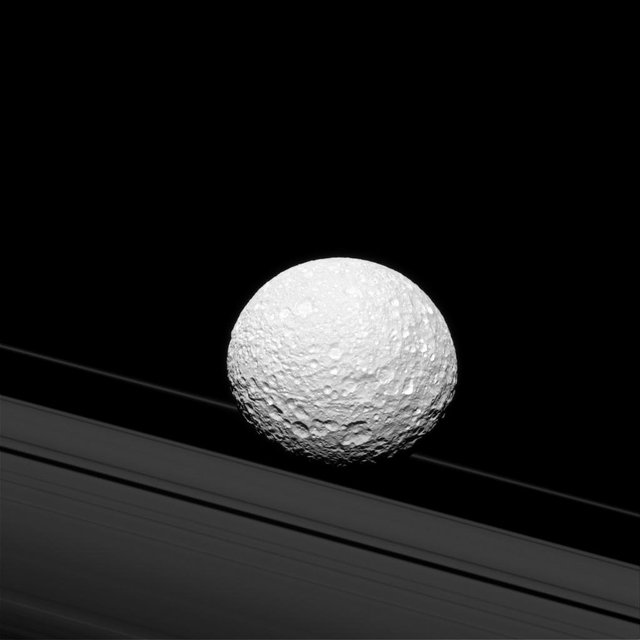Planetary moons #12 : Mimas
This is the smallest of the objects we know in the Solar System, which has a round shape. Saturn's seventh-largest satellite is only 397 kilometers in diameter and a hallmark: the Herschel crater, which corresponds to one-third of the entire moon!
Mimas with its large crater Herschel

By NASA/JPL-Caltech/Space Science Institute link [Public domain]
It was discovered in 1789 by William Herschel, the discoverer of the moon Enceladus, which I have described to you lately. Mimas is 9 times smaller than our Moon satellite, it has almost a spherical shape and circles Saturn within nearly 23 hours after the orbiting diameter of 370 thousand. kilometers. This moon, like our earthly one, is always turned one hemisphere towards its own planet. Mimas separates the rings of Saturn A and B, creating a Cassini Division. We don't know much about him.
Mimas and Saturn's rings

By NASA/JPL-Caltech/Space Science Institute link [Public domain]
Mimas has an average density of 1.15 kg / dm3, which is why it is mainly made of water ice with a small amount of rock matter. The surface of the moon reflects the majority of solar radiation, hence the temperature on the Mimas is around -200 degrees Celsius. The satellite has a large number of impact craters, and the largest of them is more than 130 km Herschel. Its depth is over 10 kilometers. The elevation in the middle of the crater is 6 kilometers high! Below is the approximation of this crater. Other craters have diameters of 20-40 kilometers.
Herschel crater on Mimas

By NASA / JPL-Caltech / Space Science Institute link [Public domain]
To this day, there were four space probes in the vicinity of this satellite: Pioneer 11 in 1979, Voyager 1 in 1980, Voyager 2 in 1981 and the Cassini spacecraft, which has been exploring Saturn's moons for over ten years. On February 13, 2010, Cassini flew 9520 kilometers from Mimas. Perhaps in the future it will be better researched. It is certainly a very distant world that is full of secrets. We know jupiter's moons fairly well, while Saturn's satellites are already distant worlds, which are currently out of our reach.
Greetings to lovers of Astronomy!
References:

Wow nice information friend, Thanks for sharing....
It's just a Death Star which is going to destroy the Earth 😀😁 NASA claims it will be caused by some asteroid but they don't want to be a scaremonger - it will be the Death Star 😆😆😂😂
There is a similarity to the film object is true :)
Hey Astronomiac! Don't be afraid to make longer posts with some "hard" scientific facts.
Go to scholar.google, find the latest discoveries and tell us about them.
It will be the whole class better and the amount of time spent will be +1 hour max.
This post has been voted on by the steemstem curation team and voting trail.
There is more to SteemSTEM than just writing posts, check here for some more tips on being a community member. You can also join our discord here to get to know the rest of the community!
Hi @astromaniac!
Your post was upvoted by utopian.io in cooperation with steemstem - supporting knowledge, innovation and technological advancement on the Steem Blockchain.
Contribute to Open Source with utopian.io
Learn how to contribute on our website and join the new open source economy.
Want to chat? Join the Utopian Community on Discord https://discord.gg/h52nFrV
As we all know, Mimas in indeed, the death star